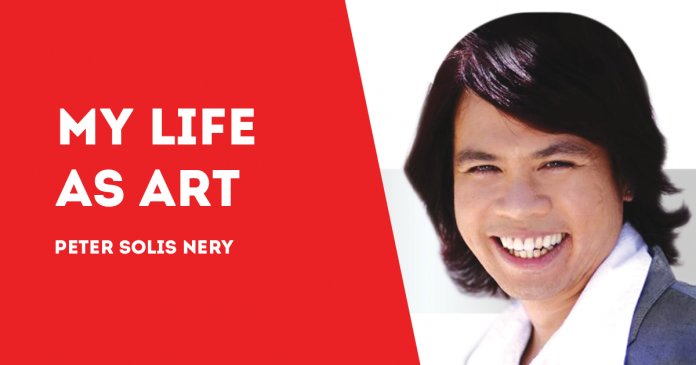
IN THE STUDY of 21stCentury Literature from the Philippines featuring the stories of Peter Solis Nery, 19-time Palanca awardee including the Hall of Fame, the following question is often asked (which, of course, your dutiful writer answers):
*
What was the political milieu that influenced you in the writing of “Donato Bugtot,” and “Si Padre Olan kag ang Dios”?
*
“Donato Bugtot,” a short story about the hunchback who was asked to donate one of his kidneys was written in the US in 2011.
I was doing a great job as an orthopedic and medical-surgical nurse in a Los Angeles hospital, but I still continue to write for Filipino readers.
It was really my nursing job that provided me knowledge and information to write about kidney transplants, which is crucial to the morality tale that was Donato Bugtot.
But if I am to force myself to think of a political milieu that could have suggested or influenced my story, it was the changing healthcare landscape in America, and the healthcare reform talks from 2008 to 2010.
It is not mentioned in the story since my story is set in the Philippines, but my preoccupation with hospitals and healthcare reforms may have subconsciously pushed me to write about a medical condition like renal failure and how it is dealt with.
I know that it is not the heart of my story, but it served a purpose.
*
“Si Padre Olan kag ang Dios” was written, and won the Palanca Awards first prize, in 2013.
The story has the El Niño phenomenon as a Man vs. Nature conflict that adds another layer to the interpersonal and internal conflicts of Padre Olan.
The actual El Niño happened in 2014-2016; and 2010-2012 were La Niña years.
The world was okay in 2013, but after La Niña, I became more aware of both La Niña and El Niño and their effects on small communities.
So I knew it was just a matter of time before I wrote something that featured them.
*
Seriously though, my goal in writing “Padre Olan” has to do with my personal perception of people’s spiritual connection with God, and the 2011 submission with the International Criminal Court of alleged crimes of the Catholic Church against humanity for all the sex scandals of the clergy.
So, in a very political way, maybe I was also trying to assess the control and relevance of the church in our modern times.
But for sure, that was not the main theme going in my mind.
I was more dedicated to my idea that “God is not a waiter who takes our orders.”
I’m really proud of my story because the previous year, in 2012, I was already inducted into the Palanca Hall of Fame.
Who knew they’d still award me another first prize after my 5thgold in 2012?
So, yeah, the Padre Olan story really made me think that I’m so good at writing Hiligaynon short stories. Haha.
*
Question: What cultural aspects did you want to convey in “Lirio,” “Ang Kapid,” “Candido,” “Donato Bugtot,” and “Si Padre Olan kag ang Dios”?
*
To be very honest, when I was in college, it was my ambition to win even just one Palanca Award in my lifetime.
Some of my favorite authors back then were Palanca winners.
But fast-forward to 2017, I have won 19 Palanca awards (nine of them gold medals) including the much coveted Palanca Hall of Fame which required five first prizes.
*
I have so much respect for the Palanca as the keeper and promoter of Philippine literature, and I’m very proud that I am part of its history.
It is my belief that to win the Palanca, my literature (stories, poems, plays, screenplays, essays) should reflect some Filipino values and culture.
I can be wrong, of course.
But I have won 19 awards, so maybe I am correct after all. Haha.
For the purposes of the Palanca, I did exactly that — convey cultural dimension, flavor, aspect, layer, whatever you call it — in all my contest pieces.
*
In “Lirio,” I wanted to dramatize the abuse of women, not because I wanted to promote and celebrate it, but precisely because I wanted to stop it.
I wanted to empower women, maybe to challenge them.
I want them to pity the character Lirio so that in doing so, they may reflect on the abuses they see around them, and maybe encourage them to do something to stop these abuses.
The Philippine society has a very macho culture, and that often hurts women.
By painting a tragic story that is easy to follow, I want readers to wake up to the abuses around them.
Right now, “Lirio” is being studied in high schools all over the country.
Let’s see how that will affect our culture in 5 to 10 years when my readers become young adults running our country, or at least taking active part in our nation building.
*
Did I celebrate the culture of silence or the maltreatment of disabled and handicapped persons in my story?
While I praised the virtue of “less talk,” I hope readers do not forget that in the end, Lirio the Mute opened her mouth to protest her condition to God, and to you, the readers.
*
We will continue with the cultural aspects explored and conveyed in four other stories in the expanding corpus of the PSN literature in my next column. (To be continued/PN)





